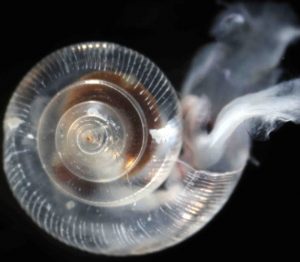Effort launched to develop biologically relevant thresholds for tracking ocean acidification

SCCWRP and its partners have launched a two-year initiative to develop a scientific foundation for using the health of marine organisms to track the biological impacts of ocean acidification (OA).
Researchers will compile global biological data on pteropods, or sea snails, and other sentinel organisms from OA literature, then use computer models of the coastal ocean to interpret and set ecologically relevant tipping points, or thresholds, at which organisms are impacted by changing seawater chemistry.
The computer models, which explain the physical and biogeochemical dynamics of the coastal ocean, are being developed by a group of West Coast researchers – including at SCCWRP – to predict how coastal ecosystems will be impacted by OA.
SCCWRP will facilitate the development of biologically relevant OA thresholds by bringing together an international consortium of OA researchers to work toward consensus on threshold setting.
Coastal resource managers will be able to use the biological thresholds in combination with OA exposure data to assess the speed and intensity with which OA is likely to impact marine communities. The assessment tools also will shed light on how marine communities are impacted by hypoxia.
The acidifying ocean has been shown to affect behavior, reproduction, growth and survival in a variety of marine species.
Researchers will initially focus on pteropods, which are marine calcifiers that depend on minerals from seawater to form their protective outer shells and skeletons. These minerals are expected to become scarcer in response to OA.
Pteropods, which are part of the base of marine food webs, are particularly relevant harbingers of OA in the Southern California Bight. The 2013 cycle of Bight regional monitoring showed that corrosive waters already are creeping into the ecologically sensitive Bight continental shelf zone, especially during upwelling events in the spring months.
In September, OA researchers from around the world will gather at SCCWRP to begin developing consensus around the thresholds at which pteropods are biologically impacted by OA.
More news related to: Climate Change, Ocean Acidification and Hypoxia